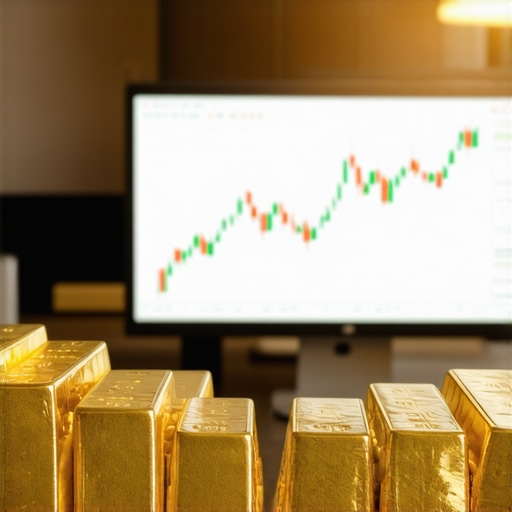Unlocking the Mysteries of Gold Price Movements in 2025
As global economies navigate post-pandemic recovery, geopolitical tensions, and shifting monetary policies, the gold market emerges as a beacon of both opportunity and complexity. For astute investors, understanding the gold price forecast 2025 means delving beyond headline figures to uncover the nuanced forces shaping the precious metal’s trajectory. This article offers expert insights drawn from seasoned analysts, data trends, and macroeconomic indicators, helping you chart a smarter investment course in gold.
Decoding Macroeconomic Signals: Why Gold Remains a Strategic Hedge
Gold historically acts as a safeguard against inflation and currency volatility. With inflation rates projected to remain elevated in several major economies through 2025, gold’s allure as a stable store of value intensifies. Central banks worldwide are adjusting interest rates cautiously, yet persistent uncertainty around fiscal stimulus and debt levels keeps gold prices buoyant. Investors should consider how these macroeconomic variables interplay: rising inflation and cautious monetary tightening typically bolster gold demand, a dynamic supported by recent market analyses such as those from the World Gold Council (source).
Supply Constraints and Demand Surges: The Twin Engines of Price Fluctuation
Mining output, recycling rates, and technological demand all influence gold’s supply side. In 2025, mining production is expected to face logistical challenges due to environmental regulations and geopolitical factors, tightening global supply. Simultaneously, demand from sectors like electronics and jewelry is anticipated to rise, particularly across emerging markets. Furthermore, increased central bank gold purchases, driven by diversification strategies, are poised to sustain upward price pressure. This interplay between constrained supply and robust demand creates a fertile ground for price appreciation, a critical consideration for portfolio strategists.
How Can Investors Leverage Gold ETFs and Physical Gold Investments in 2025?
Choosing between gold ETFs and physical gold requires balancing liquidity, security, and investment goals. Gold ETFs offer easy market access and diversification benefits, ideal for short-to-medium-term exposure. In contrast, physical gold—such as bars and coins—provides tangible asset security and is often favored for long-term wealth preservation. Expert advice suggests a hybrid approach tailored to individual risk tolerance and investment horizon. For detailed guidance, explore comprehensive strategies in choosing the best types of gold investments and the nuances of physical gold investment options.
Navigating Volatility: Expert Trading Techniques for Maximizing Gold Returns
Gold’s price volatility in 2025 offers both risks and rewards. Seasoned traders utilize sophisticated analysis tools and market indicators to time entries and exits effectively. Techniques such as futures trading, swing trading, and leveraging geopolitical event calendars can enhance return potential while managing downside exposure. For those interested in sharpening their market acumen, resources like effective gold trading techniques provide invaluable frameworks for consistent success.
Join the Conversation: Share Your Gold Investment Strategies and Questions
What are your thoughts on the evolving gold market landscape for 2025? Whether you’re a seasoned investor or just starting, sharing insights and experiences enriches our collective understanding. Leave a comment below or share this article with fellow investors seeking expert guidance on gold price forecasts and smart investment strategies.
Understanding Central Bank Gold Purchases: The Hidden Force Behind Price Movements
Central banks have increasingly become pivotal players in the gold market, using gold reserves as strategic assets for economic security and diversification. In 2025, the trend of central bank gold purchases is expected to persist, driven by geopolitical uncertainties and shifts in global currency dynamics. These purchases often serve as signals of confidence or caution, influencing investor sentiment broadly. Notably, central bank buying can tighten available supply, exerting upward pressure on prices. Investors who monitor these activities gain a nuanced edge, enabling more precise timing and allocation decisions in their portfolios. For a deeper dive, review insights on central bank gold purchases and their impact on prices.
Integrating Gold into Diversified Portfolios: Balancing Risk and Reward
While gold is often hailed as a safe haven, its role within a diversified investment portfolio requires careful calibration. Allocating between stocks, bonds, and gold must consider correlations, volatility, and economic cycles. For example, gold typically exhibits low correlation with equities, making it an effective hedge during market downturns. However, overexposure can dampen portfolio growth during sustained bull markets. Modern portfolio theory advocates for a dynamic allocation strategy, adjusting gold exposure in response to macroeconomic indicators and risk tolerance. Investors should explore smart gold investment strategies to diversify with stocks and bars for actionable guidelines on optimizing portfolio balance.
What Are the Emerging Risks and Opportunities in Gold Futures Trading for 2025?
Gold futures trading offers substantial profit potential but also involves intricate risks that require expert navigation. The 2025 market environment brings volatility stemming from inflation uncertainties, geopolitical tensions, and fluctuating currency valuations. Traders must master leverage management, technical analysis, and geopolitical event interpretation to capitalize effectively. Moreover, innovations in algorithmic trading and data analytics tools provide new opportunities for precision entry and exit points. However, these advantages come with heightened complexity and the need for continuous learning. Authoritative sources like Investopedia emphasize understanding contract specifications, margin requirements, and risk mitigation techniques to succeed in futures markets.
Harnessing Technology: How Data Analytics Transforms Gold Market Forecasting
Advanced data analytics and artificial intelligence (AI) are reshaping how investors forecast gold prices and market trends. By analyzing large datasets encompassing economic indicators, social sentiment, and geopolitical events, AI-powered models can identify patterns and potential price inflection points with greater accuracy than traditional methods. For 2025, such technologies empower investors to anticipate volatility spikes and adjust strategies proactively. However, reliance on models must be balanced with expert judgment to account for unprecedented events and market psychology. To explore effective forecasting techniques, see comprehensive resources on accurate gold price forecasts.
Call to Action: Engage with Expert Gold Market Analysis and Share Your Insights
We invite readers to deepen their understanding by exploring the linked expert resources and share their own strategies or questions in the comments section. Your contributions can illuminate new perspectives and foster a community of informed gold investors. Whether refining your approach to physical gold, ETFs, or futures trading, collective discourse strengthens investment outcomes in a rapidly evolving market.
Quantitative Models and Sentiment Analysis: Elevating Gold Price Predictions to an Expert Level
Traditional forecasting methods often rely on historical price trends and macroeconomic fundamentals, but the 2025 gold market demands more sophisticated approaches. Quantitative models integrating machine learning techniques enable analysts to parse vast datasets, including economic indicators, inflation expectations, currency fluctuations, and geopolitical event probabilities. These models dynamically adapt to new data, capturing nonlinear relationships and regime shifts that conventional models might miss. For instance, advanced neural networks and ensemble learning frameworks can detect subtle market signals, such as shifts in central bank policy sentiment or emerging supply bottlenecks, providing a predictive edge.
Moreover, sentiment analysis powered by natural language processing (NLP) algorithms mines social media, financial news, and policy statements to quantify market mood. This real-time sentiment scoring augments price forecasts by incorporating investor psychology and reaction patterns, crucial in a market as sentiment-sensitive as gold.
Investors aiming to exploit these tools should consider platforms that integrate quantitative analytics with expert interpretation, recognizing that AI-driven outputs require human contextualization to mitigate overfitting and model biases.
How do advanced quantitative forecasting models improve gold price accuracy in volatile geopolitical climates?
In volatile geopolitical contexts, traditional econometric models often falter due to abrupt regime changes and exogenous shocks. Advanced quantitative models, especially those incorporating machine learning algorithms, enhance forecast resilience by learning from complex, nonlinear data patterns and adapting to shifting correlations. For example, ensemble methods that combine multiple predictive algorithms can reduce prediction errors by balancing biases inherent in individual models. Additionally, integrating geopolitical event indicators—such as conflict escalation probabilities or trade policy uncertainties—allows these models to anticipate market reactions more accurately.
Research published by the CFA Institute Financial Analysts Journal demonstrates that models blending macroeconomic variables with sentiment indices outperform standard time-series forecasts, particularly in turbulent markets where investor sentiment rapidly shifts.
Emerging Market Demand and Technological Innovations: Catalysts for 2025 Gold Price Trajectories
Emerging economies like India, China, and Southeast Asian nations are increasingly influencing global gold demand, driven by rising disposable incomes, cultural affinity for gold, and expanding jewelry and industrial sectors. In 2025, these markets are expected to adopt cutting-edge mining technologies, including automation and AI-assisted exploration, which may optimize supply but also create transitional disruptions.
Simultaneously, innovations in gold recycling technologies and alternative sourcing methods, such as urban mining from electronic waste, could alter supply dynamics significantly. These advances promise to make gold supply more sustainable but may introduce short-term supply constraints during technology integration phases.
Understanding these nuanced shifts requires investors to monitor not only gold price movements but also technological adoption rates and regulatory environments within key emerging markets.
Risk Management in Gold Portfolio Allocation Amidst Complex Market Signals
Given the multifaceted nature of gold’s price drivers in 2025, sophisticated risk management frameworks become indispensable. Beyond classical variance-based measures, investors should employ stress testing under scenarios of rapid inflation spikes, currency crises, or unexpected geopolitical escalations. Dynamic hedging strategies utilizing options and futures can provide downside protection while preserving upside potential.
Moreover, incorporating multi-asset correlations and tail-risk assessments into portfolio construction can optimize gold’s diversification benefits. Scenario analysis tools that simulate interlinked macroeconomic shocks help anticipate gold’s behavior under extreme conditions, guiding timely rebalancing decisions.
Professionals often integrate these approaches within algorithmic trading systems, enabling real-time risk adjustments aligned with evolving market conditions.
Call to Action: Elevate Your Gold Investment Strategy with Cutting-Edge Analytical Tools
For investors committed to mastering the complexities of gold price forecasting in 2025, embracing advanced quantitative models and a holistic understanding of emerging market dynamics is essential. Explore specialized platforms and expert-led analytics to gain actionable insights beyond surface-level trends. Engage with our community by sharing your experiences with AI-driven forecasting or innovative risk management techniques—your contributions enrich the collective expertise and empower smarter gold investment decisions.
Leveraging Macro-Financial Indicators for Precision Timing in Gold Markets
Expert investors recognize that beyond conventional macroeconomic indicators, subtle shifts in cross-asset signals provide invaluable foresight for gold price movements. For instance, analyzing the interplay between sovereign bond yield curves, real interest rates, and currency strength can uncover inflection points where gold transitions from consolidation to bullish momentum. Integrating these insights with geopolitical risk matrices further refines timing strategies, empowering market participants to capitalize on transient volatility with precision.
Innovations in ESG-Driven Gold Mining: Implications for Sustainable Price Dynamics
The surge in Environmental, Social, and Governance (ESG) mandates is transforming gold mining operations worldwide. In 2025, companies adopting cutting-edge sustainable extraction technologies, such as bioleaching and renewable-powered processing, are likely to enjoy preferential capital access and enhanced stakeholder trust. These innovations may reduce operational risks and supply disruptions, thereby stabilizing long-term gold supply and influencing price trajectories favorably. Investors attentive to ESG compliance metrics can gain early signals of mining sector resilience and value creation.
What Role Does Sentiment Analysis of Central Bank Communications Play in Forecasting Gold Prices?
Sentiment analysis applied to central bank communications—including speeches, minutes, and policy statements—offers a granular view into policy intentions and market expectations. By employing natural language processing (NLP) techniques, analysts quantify shifts in hawkish or dovish tones that often precede market movements. This real-time sentiment decoding enhances gold price forecasts by revealing underlying market psychology and potential monetary policy shifts before traditional economic data is released. Such approaches are particularly crucial in 2025’s environment of rapid policy adjustments and geopolitical uncertainty.
According to research detailed in the CFA Institute Financial Analysts Journal, sentiment-based models outperform traditional macroeconomic ones in predicting short-term gold price volatility, highlighting their strategic value for sophisticated investors.
Harnessing Blockchain and Tokenization for Gold Investment Accessibility
The advent of blockchain technology and gold tokenization platforms is democratizing access to gold investments. By enabling fractional ownership and real-time trading on decentralized exchanges, these innovations reduce traditional barriers such as high entry costs and storage concerns. In 2025, the synergy of regulatory advancements and technological scalability may accelerate adoption, offering investors enhanced liquidity and transparency. However, navigating regulatory compliance and custodial risks remains paramount for leveraging these novel instruments effectively.
Integrating Advanced Risk Analytics With Dynamic Portfolio Adjustments
Incorporating multifactor risk analytics—encompassing volatility clustering, tail dependencies, and scenario-based stress tests—enables portfolio managers to dynamically recalibrate gold allocations. This proactive approach mitigates exposure during extreme market stress while preserving upside capture during bullish cycles. Algorithmic frameworks that blend quantitative risk metrics with qualitative geopolitical assessments provide an adaptive shield against unpredictable shocks, positioning portfolios to thrive amid 2025’s complex market environment.
Call to Action: Transform Your Gold Investment Approach with Cutting-Edge Analytical Techniques
Elevate your gold portfolio management by embracing these advanced analytical methodologies and technological innovations. Engage with our expert community to exchange insights on ESG impacts, sentiment-driven forecasting, and blockchain-enabled investments. Share your strategies or inquire about integrating these sophisticated tools into your investment process to stay ahead in the evolving gold market landscape.
Frequently Asked Questions (FAQ)
What factors primarily influence gold prices in 2025?
Gold prices in 2025 are shaped by a confluence of macroeconomic indicators such as inflation rates, central bank monetary policies, geopolitical tensions, supply constraints from mining and recycling, and evolving demand from emerging markets and technology sectors. Additionally, advancements in quantitative models and sentiment analysis provide deeper insights into price movements.
How do central bank gold purchases impact the market?
Central banks act as significant buyers of gold, using it to diversify reserves and hedge against currency risks. Their purchasing activities reduce available supply and often signal economic confidence or caution, which influences investor sentiment and can drive prices upward, especially amid geopolitical uncertainties.
Should investors prefer physical gold or gold ETFs in 2025?
Both investment vehicles have merits: physical gold offers tangible security and long-term wealth preservation, while gold ETFs provide liquidity and ease of trading. A hybrid approach tailored to individual risk tolerance, investment horizon, and portfolio goals is often recommended.
What role does technology play in forecasting gold prices?
Technologies like artificial intelligence, machine learning, and natural language processing enable the analysis of vast datasets—including economic indicators and sentiment from news and social media—to improve the accuracy of gold price forecasts. These tools help anticipate market inflections and volatility with greater precision than traditional methods.
How can investors manage risks associated with gold investments?
Effective risk management involves diversification, dynamic portfolio allocation, stress testing under various economic scenarios, and employing hedging instruments like options and futures. Integrating multi-asset correlation analysis and tail-risk assessment further optimizes exposure to gold’s volatility.
What impact do ESG innovations in gold mining have on prices?
ESG-driven mining innovations enhance sustainability and reduce operational risks, which can stabilize supply and potentially support favorable price dynamics. Investors attentive to ESG compliance may identify mining companies with stronger long-term resilience and value creation potential.
How does sentiment analysis of central bank communications help investors?
By quantifying the tone and language in central bank statements, sentiment analysis reveals shifts in monetary policy stance before official economic data releases. This real-time insight enables more timely and accurate gold price predictions, which is crucial in the rapidly changing 2025 economic environment.
Are gold futures trading strategies still effective in 2025?
Yes, gold futures remain a valuable tool for traders to leverage price movements. However, success demands mastery of leverage, technical analysis, and geopolitical event interpretation, alongside continuous adaptation to market innovations such as algorithmic trading and advanced analytics.
What are the emerging demand trends for gold in 2025?
Emerging markets in Asia are driving increased demand for jewelry, electronics, and investment-grade gold. Technological innovations in mining and recycling also influence supply dynamics, creating both challenges and opportunities for price trajectories.
How does blockchain and tokenization affect gold investing?
Blockchain-based tokenization democratizes access to gold by enabling fractional ownership, improving liquidity, and enhancing transparency. In 2025, regulatory developments and technological scalability may accelerate adoption, though investors must remain vigilant about compliance and custodial risks.
Trusted External Sources
- World Gold Council (WGC): The WGC provides authoritative data on gold demand trends, supply dynamics, and investment insights, serving as a foundational resource for understanding market fundamentals.
- CFA Institute Financial Analysts Journal: This peer-reviewed journal publishes rigorous research on financial forecasting models, sentiment analysis, and macroeconomic impacts relevant to gold price prediction and investment strategies.
- Investopedia: A comprehensive educational platform offering detailed explanations on gold futures trading, investment vehicles, and risk management techniques, valuable for both novice and experienced investors.
- International Monetary Fund (IMF): The IMF offers macro-financial data and analysis on global economic indicators and central bank policies that directly influence gold markets.
- Harvard Business Review (HBR): HBR covers innovations in ESG practices, technology adoption in mining, and strategic portfolio management, providing insights into sustainability and advanced investment frameworks.
Conclusion
In navigating the complex gold market landscape of 2025, investors must integrate a multi-dimensional understanding of macroeconomic forces, supply-demand dynamics, technological advancements, and geopolitical considerations. The evolving roles of central banks, emerging market demand, and ESG-driven mining innovations underscore gold’s enduring strategic value as a hedge and investment asset. Advanced quantitative models and sentiment analysis elevate forecasting precision, empowering sophisticated market timing and risk management. By embracing a balanced approach—leveraging physical assets, ETFs, futures, and blockchain innovations—investors can optimize portfolio resilience and capitalize on gold’s unique diversification benefits. Engage with this evolving discourse, share your insights, and harness expert analytics to refine your gold investment strategy for a dynamic 2025 and beyond.










